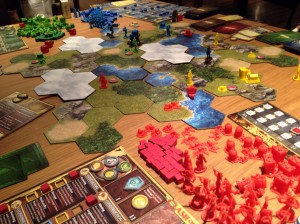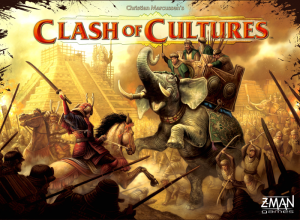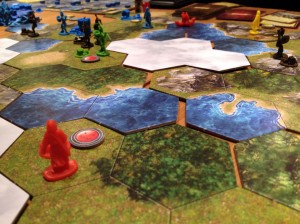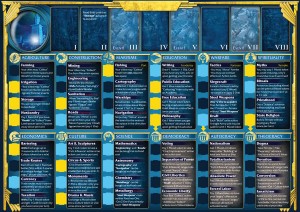Review: Clash of Cultures
Posted by James (admin) on November 16th, 2012

A player board can be seen at the bottom of the picture. Notice the cubes in the square holes marking the advances gained.
Clash of Cultures is a civilisation building game by the designer of Merchants and Marauders and this sole fact meant it was on my ‘must play’ list as Merchants & Marauders was a superb game. In Clash of Cultures, players start as rival tribes in corners of the realm with no technology. Over 6 rounds, the players explore the land, generate resources, build cities, create technologies, trade, potentially fight each other, and do whatever they can to be the most successful. At the end of the game, victory points (VPs) are scored for building cities (1VP per piece), advances in technology (1/2VP each), completing objective cards (2VP each) and building wonders (5VP each) – the player with the most VPs wins.
GAME
The board/map is made of tiles (each showing 4 hexes) of various types: water, mountains, barren, grassland, forest. Unexplored regions remain face-down until entered when a player turns the tile over and sometimes gets a choice on its orientation.
Players all start the same with 1 settler, the Farming and Mining advances and 1 basic city. During the game, cities can be improved by adding a port, academy, temple and/or fortress. The size of a city is equal to the total number of pieces – the bigger the size, the more resources it collects and influence it has; however, city size is limited by the number of cities you own so you can’t just have one super-city. A city that is happy functions like a city of 1 larger size; whereas, an angry city functions like a city of size 1.
Actions
Each of the 6 rounds is broken into 3 turns when each player will carry out 3 actions each. An action can be used to:
- Gain an advance – Gain 1 advance (costing 2 food or 2 ideas)
- Found a city – A settler figure in a non-barren location can be replaced with a city
- Activate a city
- Spend resources to add an improvement (fortress, port, academy or temple)
- Spend resources to build units (settler, troop, ship)
- Collect resources equal to their size (so larger cities gather more in 1 action) from the city’s terrain and empty neighbouring terrains (fields/food, mountains/ore, forest/wood). Each terrain can only be gathered from once each action, so if your city only has access to 1 mountain terrain then you can only gather a maximum of 1 ore each action.
- Move Units – Move up to 3 groups of units. Ships can move to any connected sea space, and can move around the edge of the map with the Navigation advance.
- Civic improvement – Spend mood tokens equal to the city’s size to increase a city’s mood one step
- Cultural influence – Try converting a city piece in an opponent’s city near yours. For example, make an opponent’s port into your port in their city. Spending culture tokens gives you a better chance of success and/or longer range.
Advances
In front of each player is a player board which records the player’s resources (food, ore, wood, ideas and gold) and their population’s levels of culture and happiness. The main area of the player board shows the 48 different advances in technology (simply called ‘advances’). When gaining an advance, players record this by placing a cube in the hole next to the relevant advance’s description (you can see this in the lower section of the photo at the top of this page).
Advances give you various advantages and abilities; for example, Tactics (warfare) allows you to move troops, Fishing (maritime) allows you to collect food from sea spaces, Storage (agriculture) allows you to store more than 2 food, Sanitation (construction category) makes you immune to plague and epidemic events, and so on. Some advances are required before you can gain some others, but in general you just need the top-most advance before any of the others in a category.
When you gain some advances, you gain a level of happiness or culture. When either of these reaches 3, 5 or 7, you draw an event card (which can sometimes affect everyone) which can be barbarians attacking your cities to plague breaking out. Some can be positive, but we saw enough negative ones that we all braced ourselves every time someone drew one.
Combat
Combat is quite simple. Players roll 1 dice for each of their involved units and divide the total by 5 – the result is the number of enemy units that are removed. Combat continues until one side is wiped out, or the attacker chooses to stop. Players with the Tactics advance can play 1 of their cards for its combat ability to gain an advantage. Players can battle opponent’s units, neutral barbarians, or even opponent’s cities – ships can also battle ships.
Game End
After 3 turns, the round ends. Players receive 1 advance, 1 action card (giving you a special power) and 1 objective card (giving you personal goals that will earn you VPs if you fulfil them). Both types of card also have special combat powers on them too so they are multi-purpose.
 THOUGHTS
THOUGHTS
The first things that strikes you when you set-up Clash of Cultures is that the figures not only look great (and there are plenty of them) but the pieces that make a city are very clever. The central city piece is circular and the extra improvements (fortress, etc.) fit around the outside so that not only can all 5 pieces combine to make a large circular city but, when an improvement is controlled by an opponent, the opponent’s colour piece can be placed in the city instead, i.e. a yellow city with a red fortress piece. The game benefits from each city improvement are nicely different too.
As you would expect from a civilisation game, resource management is key to success – in Clash of Cultures, having bigger cities (and some advances) is more efficient, but these require resources and advances to build them.
However, action management is critical (maybe even more than resource management) to success, because you only get 3 actions each turn (9 per round). So, you must make the most of every single action to maximise your gains. Teasingly, you will usually find yourself wanting just 1 extra action so you could achieve something even better – I believe this is always the sign of a good game design and you look forwards to your next turn.
Mood and Culture are interesting aspects which are integrated well into the game too – they’re subtle and thematic, but still important. Having an angry city is quite crippling as they can gather only 1 resource per action, can not grow and can only be used once per turn. Having lots of culture tokens means you can take over parts of other cities, plus they’re important to build wonders. Mood tokens can also be an important commodity too.
The advances system is excellent and is core to the game. Not only are there 48 advances to choose from, but these can be mixed in many ways because most do not require other advances first. Players are tempted to dabble in several categories as some are required before you can build certain city improvements, i.e. you must have the Writing (education) advance before you can build a library. The advances are all interesting (although you’ll find some more appealing than others depending upon your current needs and status) and work well thematically, plus some also give players access to new actions. Some advances increase the player’s happiness or culture level and this adds an extra factor when deciding which to build next. The player board wth cubes in each slot
As a result of both the actions mechanic and the advances mechanic, you really have a lot of choice each turn and can really choose how you want to develop your civilisation – not just which advances you gain, but what you build, where you explore, how you gather resources, where you start new cities, etc.

In addition to building cities and advances, I like how the VP system encourages players to prioritise their objective cards which can deliver a lot of VPs and they are quite varied so you start developing in ways you probably would not have considered otherwise. Plus, the objectives mean each player has a different perspective of the game which is another aspect I like in games.
There seems to be plenty of variety in replay due to the varied map each game, as well as the varied event cards, objective cards, plus the way each player develops.
I’m not a very experienced player of civilisation-style games (my opponents were seasoned veterans). However, I was very pleased to see that my peaceful ways managed to secure me 2nd place as I used trade routes and ships to gather lots of resources (eventually) and build 2 wonders (which are expensive). This was with a small amount of asking one nearby player not to attack me as I posed no threat to them – primarily because barbarians had already destroyed one of my peaceful cities (I only had 2!). I had the last laugh on the barbarians though as I used my city’s cultural influence to convert one of their settlements into a new city for me (hurrah), although this was then invaded by another player (boo).
In the end, I really enjoyed Clash of Cultures due to all the options and strategies I had to decide between. If you’re a trader or explorer, you don’t have to be a pushover and can still quickly toughen up your defences – especially as the paranoia of a nearby, well-armed opponent (or neutral barbarians who have a tendency to attack) is always lurking. The objective cards and advances definitely made me pursue things I would not have thought of and there are lots of different things I’d like to pursue in future games.
James.
[Played with 4 players]
Read the rules on the Z-Man Games web site: here


